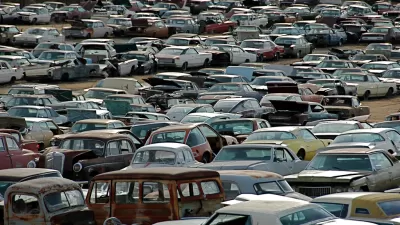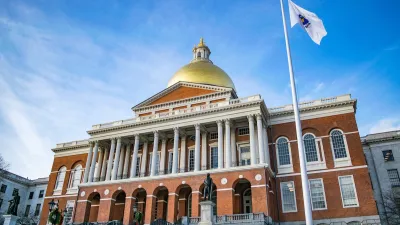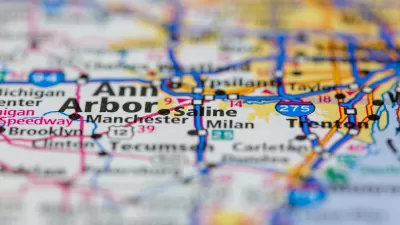The new report, "Who Pays for Roads? How the 'Users Pays' Myth Gets in the Way of Solutions to America’s Transportation Problems" exposes the widening gap between how Americans think we pay for roadways—through user fees—and how we actually do.

As Congress struggles to renew the federal transportation law, a new report from the U.S. Public Interest Research Group [U.S. PIRG] and Frontier Group finds that drivers currently pay less than half the total cost of roads, and argues that while increasing gas taxes could fill the shortfall, it would leave other problems unaddressed.
The new report, “Who Pays for Roads? How the ‘Users Pays’ Myth Gets in the Way of Solutions to America’s Transportation Problems” exposes the widening gap between how Americans think we pay for transportation – through gas taxes and other fees – and how we actually do.
The new report comes with just a month left before expiration of the federal transportation act, and with the federal Highway Trust Fund on the brink of insolvency. Revenues from gas taxes and other user fees this year are expected to come up $16 billion short of the level needed to maintain current federal transportation spending, leading to the need for urgent congressional action.
“Congress is stuck in an endless loop,” said Phineas Baxandall, Senior Analyst at U.S. PIRG and coauthor of the report. “Either Congress will have to raise gas taxes to the high levels that would be needed to fully pay for the costs of highways or it will have to admit that the ‘users pay’ system no longer exists and needs to be reformed.”
The new report pulls back the veil on the “users pay” myth, finding that:
· Gas taxes and other fees paid by drivers now cover less than half of road construction and maintenance costs nationally – down from more than 70 percent in the 1960s – with the balance coming chiefly from income, sales and property taxes and other levies on general taxpayers.
· General taxpayers at all levels of government now subsidize highway construction and maintenance to the tune of $69 billion per year – an amount exceeding the expenditure of general tax funds to support transit, bicycling, walking and passenger rail combined.
· Regardless of how much they drive, the average American household bears an annual financial burden of more than $1,100 in taxes and indirect costs from driving – over and above any gas taxes or other fees they pay that are connected with driving.
“The ‘users pay’ myth is deeply ingrained in U.S. transportation policy, shaping how billions of dollars in transportation funds are raised and spent each year,” said Tony Dutzik, co-author of the report and Senior Analyst at Frontier Group, a non-profit think tank. “More and more, though, all of us are bearing the cost of transportation in our tax bills, regardless of how much we drive.”
“We need to dispel the myth that user fees are paying for the building and maintenance of our road network. The reality is that these funds are barely covering a fraction of the cost,” said Gabe Klein, SVP of Fontinalis Partners, and former Commissioner of Transportation for Chicago and Washington, D.C. “The highest return on investment is on bike, pedestrian and transit projects,” he said.
State and federal policies often give priority to spending on highways based on the assumption that drivers pay the cost of roads through gas taxes and user fees. The report argues that, with the nation’s transportation needs changing and general taxpayers bearing an ever-greater share of the cost of transportation, America should instead invest transportation dollars in projects that are likely to deliver the greatest benefits.
Ordinary Americans agree. Nearly two-thirds of Americans believe it is appropriate to use gasoline tax revenue to support public transportation, according to a national study released last week by researchers at the Norman Mineta Transportation Institute. Other recent opinion polls suggest that Americans believe that the nation should give greater priority to transit, bicycling and walking in transportation spending.

Alabama: Trump Terminates Settlements for Black Communities Harmed By Raw Sewage
Trump deemed the landmark civil rights agreement “illegal DEI and environmental justice policy.”

Study: Maui’s Plan to Convert Vacation Rentals to Long-Term Housing Could Cause Nearly $1 Billion Economic Loss
The plan would reduce visitor accommodation by 25% resulting in 1,900 jobs lost.

Planetizen Federal Action Tracker
A weekly monitor of how Trump’s orders and actions are impacting planners and planning in America.

Waymo Gets Permission to Map SF’s Market Street
If allowed to operate on the traffic-restricted street, Waymo’s autonomous taxis would have a leg up over ride-hailing competitors — and counter the city’s efforts to grow bike and pedestrian on the thoroughfare.

Parklet Symposium Highlights the Success of Shared Spaces
Parklets got a boost during the Covid-19 pandemic, when the concept was translated to outdoor dining programs that offered restaurants a lifeline during the shutdown.

Federal Homelessness Agency Places Entire Staff on Leave
The U.S. Interagency Council on Homelessness is the only federal agency dedicated to preventing and ending homelessness.
Urban Design for Planners 1: Software Tools
This six-course series explores essential urban design concepts using open source software and equips planners with the tools they need to participate fully in the urban design process.
Planning for Universal Design
Learn the tools for implementing Universal Design in planning regulations.
Caltrans
Smith Gee Studio
Institute for Housing and Urban Development Studies (IHS)
City of Grandview
Harvard GSD Executive Education
Toledo-Lucas County Plan Commissions
Salt Lake City
NYU Wagner Graduate School of Public Service





























